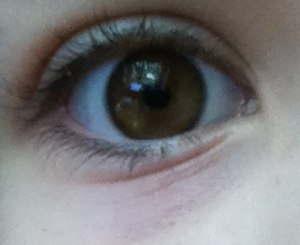Dennie–Morgan fold
| Dennie–Morgan fold | |
|---|---|
 | |
| Dennie–Morgan fold below the lower eyelid |
A Dennie–Morgan fold, also known as a Dennie–Morgan line or an infraorbital fold, is a fold or line in the skin below the lower eyelid. It can simply be an ethnic/genetic trait,[1] but was found in one study to occur in 25% of patients with atopic dermatitis.[2] The presence of Dennie–Morgan folds can be used as a diagnostic marker for allergy with a sensitivity of 78% and specificity of 76% according to one study.[3][4][5][6]
Such folds are also common among certain ethnic groups such as Africans,[1] Tatars, Slavs, Balts and Finnic peoples, and are not known to be associated with any medical condition in these.[citation needed]
The pathophysiology of this sign is not clear. One proposed mechanism is that continuous spasm of the superior tarsal muscle and skin edema could be due to hypoxia from poor circulation.[2]
A Dennie–Morgan fold should not be confused with an "allergic shiner", which is a purple-gray discoloration with associated fullness beneath the lower eyelid. This is related to the accumulation of blood and other fluid in the infraorbital groove resulting from nasal congestion.[2]
See also[]
References[]
- ^ Jump up to: a b Williams HC, Pembroke AC (January 1996). "Infraorbital crease, ethnic group, and atopic dermatitis". Archives of Dermatology. 132 (1): 51–4. doi:10.1001/archderm.1996.03890250061010. PMID 8546483.
- ^ Jump up to: a b c Blanc S, Bourrier T, Albertini M, Chiaverini C, Giovannini-Chami L (June 2015). "Dennie-Morgan fold plus dark circles: suspect atopy at first sight". The Journal of Pediatrics. 166 (6): 1541. doi:10.1016/j.jpeds.2015.03.033. PMID 25890677.
- ^ Schram ME, Leeflang MM, DEN Ottolander JP, Spuls PI, Bos JD (September 2011). "Validation and refinement of the Millennium Criteria for atopic dermatitis". The Journal of Dermatology. 38 (9): 850–8. doi:10.1111/j.1346-8138.2011.01202.x. PMID 21453318.
- ^ Morgan DB (June 1948). "A suggestive sign of allergy". Archives of Dermatology and Syphilology. 57 (6): 1050. doi:10.1001/archderm.1948.01520190129018. PMID 18098747.
- ^ Uehara M (October 1981). "Infraorbital fold in atopic dermatitis". Archives of Dermatology. 117 (10): 627–9. doi:10.1001/archderm.1981.01650100029022. PMID 7283456.
- ^ Mevorah B, Frenk E, Wietlisbach V, Carrel CF (1988). "Minor clinical features of atopic dermatitis. Evaluation of their diagnostic significance". Dermatologica. 177 (6): 360–4. doi:10.1159/000248607. PMID 3234581.
- Immune system disorders
